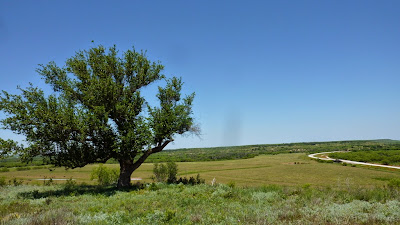Located just north of present-day Albany, Texas, Ft. Griffin was established in 1867. Troops stationed at the fort were responsible for escorting government mail, protecting surveying parties, cattlemen, buffalo hunters, etc., and pursuing and punishing Indians raiding the frontier.
"The Flat," a helltown located adjacent to the fort, was one of the most active and important embarkation and supply points for buffalo hunters. Known as the site of the first meeting of Wyatt Earp and Doc Holiday, other famous and infamous visitors included Dave Rudabaugh, John Wesley Hardin, Bat and Jim Masterson, John Larn, and John Selman. The latter, known as the killer of Hardin, worked there as a deputy sheriff. "Lottie Deno," a fabulous character and famous as the prototype for saloon owner 'Miss Kittie' in television's "Gunsmoke" was also a resident of The Flat.
(Lottie Deno)
Forts Griffin and Richardson were established in 1867. On May 16, 1867 twelve cowmen were rounding up cattle off Salt Creek about five miles southeast of Olney, Tx. They had rounded up about five hundred over the previous few days all the while seeing fresh sign that hostiles were in the area. Cautious, they had bedded down the previous evening about two miles from the herd realizing it was a very tempting target for any raiders.
That morning after drifting the herd for about four miles and spotting several cattle grazing in the distance, the trail boss, Ira Graves, sent two men off to round them up. Having gone a short distance the two men heard the shrill voices of Indians behind them. Looking back they saw a large party of Indians had surrounded the cattle and other herders about a mile back. They were loosely surrounded, but no attack had been made.
Seeing they could head for some timber about a half-mile away one said, "We can get away without any trouble." The other responded, “What sort of a tale will we tell when we get home?” With that, they turned toward their surrounded group and agreeing one would fire to the right, the other to the left if a fight broke out, headed back at a gallop. Some of the Indians met them about half-way falling in behind, herding them toward the others. Knowing they all had to make a break as they drew near, one of the men proposed making a run for the timber. A returning cowboy responded that would be suicide and, pointing out a small copse of trees about three hundred yards away, suggested they head for that. Evidently, some of the hostiles understood him and broke just before them toward the same place as the cowboys all turned and moved in the suggested direction. The hostiles got there first and turned opening fire on the oncoming cattlemen. The cattlemen then swerved into a small "basin of a place" and, upon assessing their situation, all but one, the negro cook, released their horses when another pointed out they would have no further use of them. The cook's horse was shot by the Indians almost immediately.
According to W.C. Kutch, one of two previously isolated cowbows, "The fight continued from ten o’clock in the morning till four o’clock in the evening. Will Crow was killed at the commencement of the fight, George Lemly was wounded twice, John Lemly was wounded twice, Rube Segress was wounded twice, Shapp Carter was wounded twice, Jim Gray was wounded twice, I was wounded three times, Jesse McClain was wounded once; Henry Harrison, Joe Woody and the negro, Dick, were not wounded."
Running low on ammunition it was decided that the wounded would load while the others fired. Doing this they put up an obviously spirited defense wounding many of the attackers. Finding head-on attacks especially harrowing the hostiles changed tactics and tried sneaking up the creek branch below the position but halted after five or six attackers fell wounded. Later, concentrating their fire toward the obvious, and inactive, leaders, the cowmen created sufficient concern to cause the Indians to loose a final volley then abandon the attack driving the cattle away as they left.
The successful cowmen dispatched one of the only three unwounded members for help then spent a tortuous night standing guard and helping each other and the wounded as they could. The next morning three men showed up with a wagon. By that time the third member of the group had died leaving nine survivors. The last to die was C.L.(Shap) Carter, the rider who had asked, “What sort of a tale will we tell when we get home?”
Such was the mettle of these hardy men of the Texas prairie.
Contemporary accounts of the Salt Creek fight (There is also some excellent information on the other fights discussed in this blog.)
In this blog I have told the story of three of raids.
Elm Creek Raid Oct. 13, 1864
Salt Creek fight May 16, 1867
Warren Wagon Train fight May 18, 1871
The following map illustrates their position vis-a-vis the forts visited.
This map, with much of the information contained herein comes from the The Most Dangerous Prairie In Texas. (This site details a very good history of the Indian wars, and the forts and people involved.)
Entering Fort Griffin State Park you immediately notice a high hill overlooking the entire area. Under the military precept "take the high ground," I immediately turned Betsy toward the top of the hill.
Coming down from the hill a road bends around to the old fort area. I was running late so took a quick look toward the site and hit the road. The following photos were pulled from a search of Fort Griffin images.
I would have liked more time to explore but my interest has always been in the "lay of the land," and understanding the history of a place.









No comments:
Post a Comment